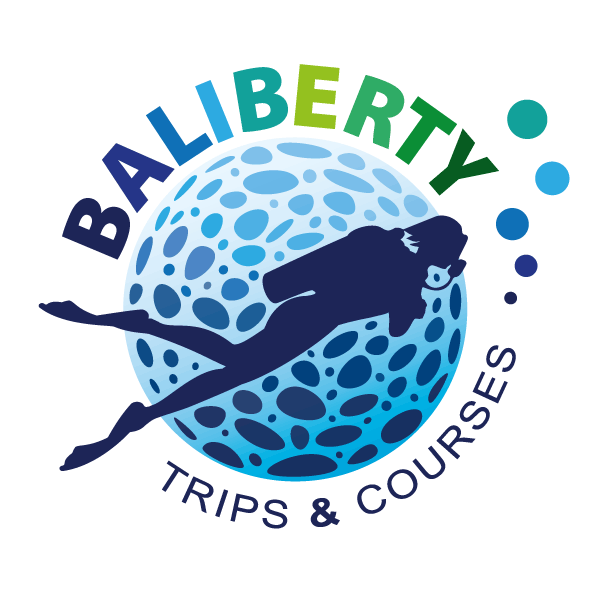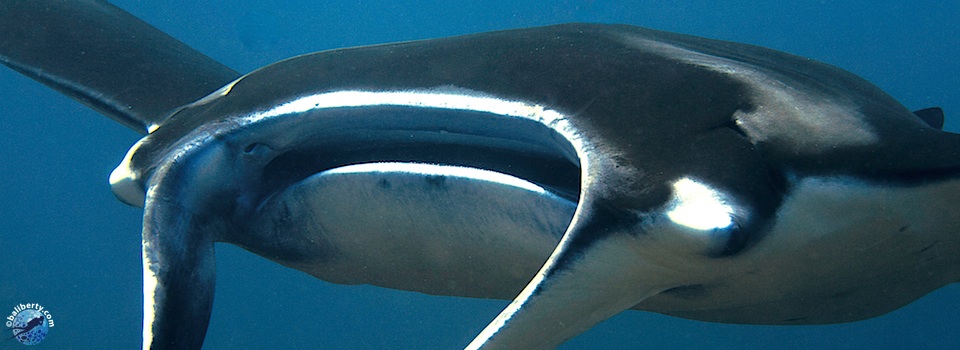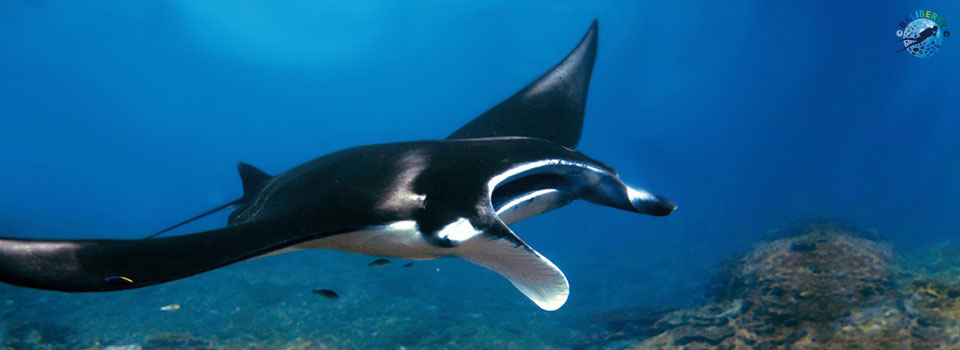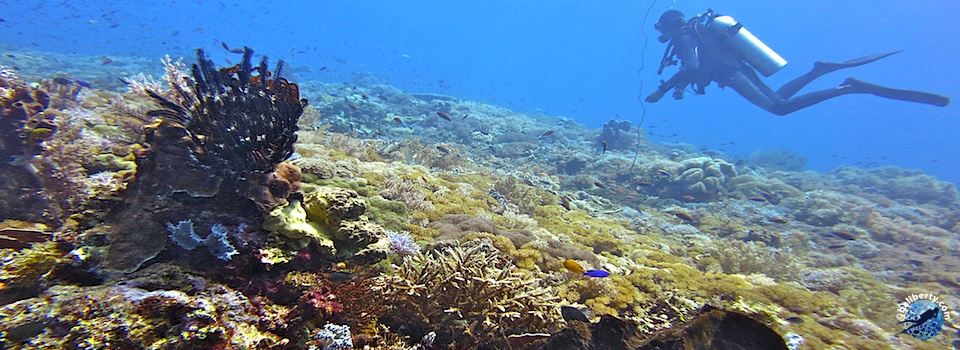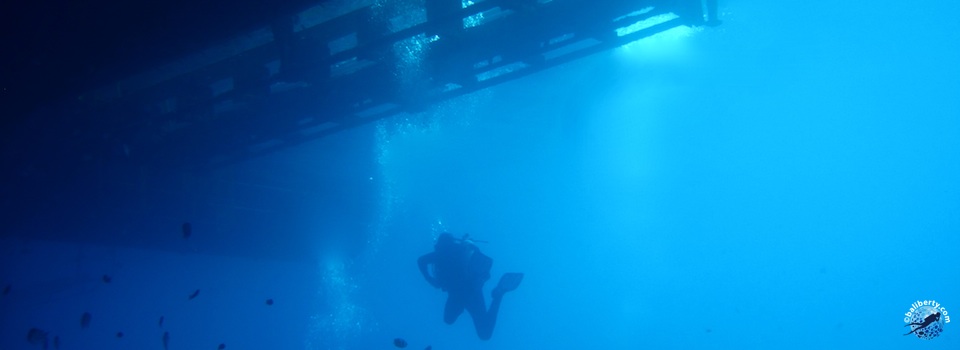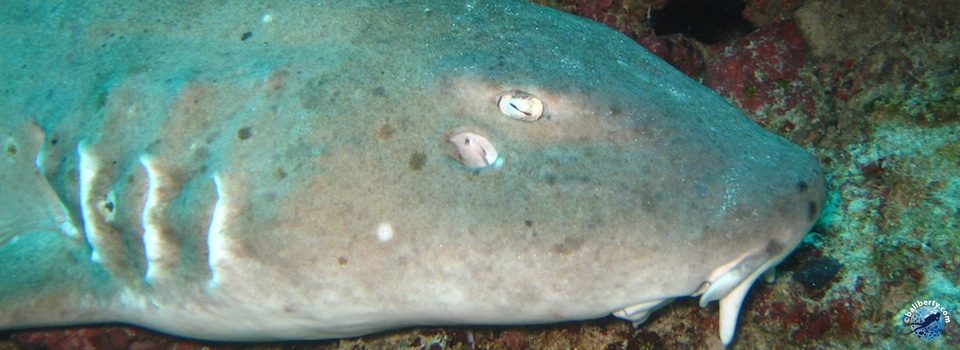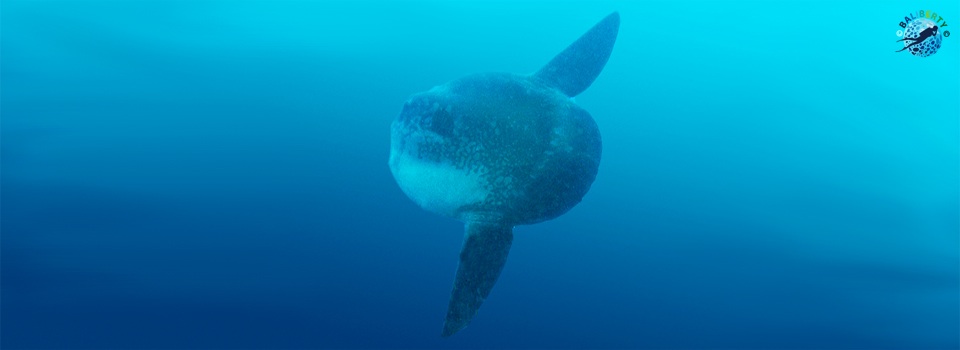- Home
- Dive sites
- Nusa Penida / Lembongan
Nusa Penida & Lembongan
The three islands of Lembongan, Ceningan and Penida are well worth a look and are located at 40mn from Bali by boat.
They offer about a dozen different dive sites.
Nusa Lembongan is the closest to Bali and is the most developed due to its algae culture.
Nusa Ceningan is the smallest and most discrete due to its lack of infrastructures.
Finally, Nusa Penida is the largest but least populated of all three islands.
It offers quite a wild environment with its cliffs and arid plateaus.
According to the local beliefs, the island is cursed and inhabited by evil spirits.
This place used to be a prison back in the days.
Located between Bali and Lombok, these three islands, are exposed to fierce currents.
Flowing from the Pacific to the Indian oceans, they make for a very good visibility (ascending thermoclines).
Between June and October, you may see the mola-mola (sunfish). It rides these currents to warm up at shallower depths and treat itself to a cleaning session. Nusa Penida is THE cleaning station by excellence.
Nusa Penida and Nusa Lembogan offer more challenging drift dives than Bali, due to stronger and more freakish currents. The north coast and the strait between the 3 islands are the most exposed areas.
There is also non-drift diving inside the bays (Gamat Bay – Crystal Bay) or on the south coast of Penida (Manta Point). There is no current at the bottom of the south cliffs. However, the swell of the Indian Ocean is still present. Grottos, caves, creeks, pinnacles and small islands take part in making this area a gem of wilderness.
Here are some of the best dive spots of the region.
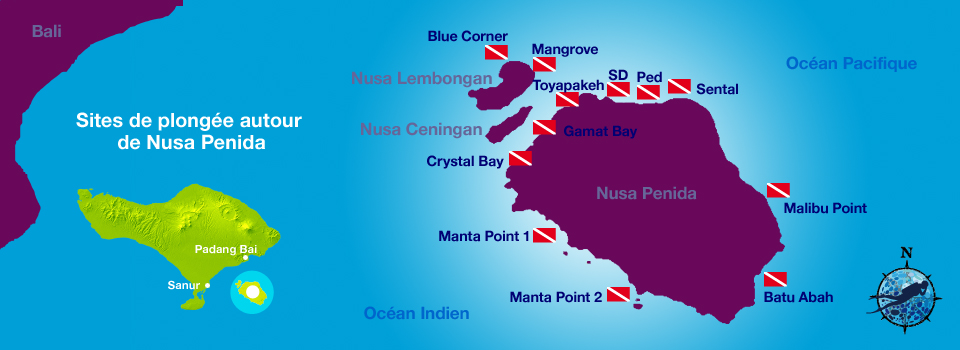
MANTA POINT 1 & 2
Type: manta rays
Minimum level: Open Water
Depth: 10 to 20 m
Current: light
Visibility: 10 to 20 m
Access: dive boat
Remarks: surface swell and underwater surf.
Location: South coast of Penida.
Both sites are shallow (8 to 20m) and covered with limestone and sandy residue.
Manta Point 1 is less affected by swell than is Manta point 2 because it is sheltered by the cliffs: a bay composed of many cavities and creeks. Even though the water can reach 20 to 24 degrees, a 5mm wetsuit should be considered.
Manta Rays can range from 2 to 4m width, 5m being the largest ever seen in June 2012 (see article). Harmless and majestic, these rays come, go and hover around the limestone seascape.
The best way to appreciate their elegant ballet is to remain at the same spot in neutral buoyancy.
Don’t follow them, they might get scared.
Avoid any contact with them, the coral and the local flora.
Don’t be sad if they don’t show up … it’s part of the game.
Look around, there is more to see …
Fauna : manta ray, white tip shark, nurse shark, turtle, sea snake, clown trigger, red tooth trigger, blue spotted stingray.
CRYSTAL BAY
Type: photography, macro, snorkeling
Minimum level: Open Water to experienced
Depth: 10 to 40 m
Current: medium to strong
Visibility: 15 to 30 m
Access: dive boat
Remarks: white sand beach, changing currents, mola-molas.
Location: 2km south of Gamat Bay, western coast of Penida.
Correctly named “Crystal bay”, clear & cold waters offer a visibility up to 25m.
In the middle of the bay, lies a large rock around which you will dive, starting with the white sanded shallow waters (8m) inside the bay.
West Coast of the rock is exposed to strong currents and swell of the Indian Ocean from the South-West. That is why we avoid diving that side.
Beginning of the dive, coral and rocks are scattered. Then, a plateau is overview (between 6 and 12 m) covered with hard corals, anemones and soft corals. Further, the plateau gives way to a steep slope down to more than 40 m. The impressive spectacle: fish from all sides, sponges, corals and also canyon housing sharks, turtles and moray eels.
Facing the West, a cold, vast and infinite blue unknown (thermocline at 16 °) with a chance to see sunfish.
Fauna:
Mola mola-, white tip shark, black, leopard shark, eagle ray, lobster, triggerfish, sweetlip, octopus, snapper, sweetlip, snake, eel, turtle
Mangrove
Type: Drift
Minimum level: level 1 +
Depth: 8-25 m
Current: moderate to strong
Visibility: 10-20 m
Access: dive boat
Remarks: drift diving excellence
At the Northeastern tip of Nusa Lembongan, Nusa near the Strait of Ceningan.
The site takes its name from the large area of mangrove between Lembongan and Ceningan.
Mangroves play a very important role in the local ecosystem and contributes to the health of the reef, reflected in the quality of landscape, abundant, healthy and varied.
From 8 to 20 m, the gentle slope is entirely covered with sponges, table corals, soft corals, clams, feather stars, anemones … The perfect place for many fishes, large or small, reef and pelagic.
The show is so dense that you will not know where to look. A feast for the eyes, everywhere.
The current here can be moderate to strong, depending on the tide or the full moon. If it is a day with current, stay neutraly buoyant, face the scenery decorated and let yourself get pushed!
This is often the second or third dive of the day that is made here.
Faune:
Barracuda, mackerel, turtle, triggerfish, coachmen fish, damsel, trumpet, carrangue, moray eel, sweetlip, snapper, diagram, batfish.
Toyapakeh
Type of dive: drift, photo, snorkeling
Minimum level: level 1 +
Depth: 6-25 m
Current: moderate to strong
Visibility: 15-30 m
Access: dive boat
Remarks: the easiest dive site of the island
At the northwestern tip of Nusa Penida, Nusa near the Strait of Ceningan.
Protected from currents, Toyapakeh offers exceptional variety and density of coral and a very good visibility.
Here is an amazing topography : highlights rocks, coral formations, atypical rugged carpet.
The reef is healthy, hosts many gorgoniae fans and home to many reef fishes that can reproduce.
Below, the vision is surprisingly between science fiction and anticipation! ( see article with Jochem).
The dive starts at 6 m by a coral garden, then a plateau between 10 and 15 m. It ends by a slope between 21 and 28 m where pelagic & sunfish can be met.
Fauna:
Anthias, scorpionfish, moray eel, trumpet fish, fish, trevally, sweetlip, snapper, chark, banded snake, batfish, turtle
SD, PED et SENTAL
Type of dive: wall, drifting, snorkeling
Minimum level: level 1 +
Depth: 6-25 m
Current: moderate to strong
Visibility: 18-30 m
Access: dive boat
Remarks: beautiful coral garden, very ornamented walls
A long coral reef borders, the entire northern coast of Penida Toyapakeh to Sental.
This reef is very rich, a splendid marine life including table corals, soft corals, sponges, gorgonians, multicolored fish.
Although the 3 sites, SD, PED and Sental are similar, we prefer diving SD, which has to our mind a greater variety of corals.
SD is also the place where the Quicksilver platform is moored: floating base with daily dozens of tourists for water sports (snorkeling, waterskying or banana boat).
The reef starts at 3 m , descending steeply to 25 m.
The scenery is spectacular inlaid coral, teeming fish crevices walls.
The current here is permanent and moderate.
Beware : during a single dive, it can change direction & intensity, bringing you back to the West Toyapakeh. To 25-30 m, pelagic are visible.
Snorkeling lovers can also take advantage of the sites, ensuring not to be deported.
Tip: choose a visual landmark, a fixed element on earth.
Fauna:
barracuda, tuna, carrangue, moorish Idol, manta ray, white/black tip shark.
GAMAT BAY
Type: photo, macro, buoyancy, snorkeling
Minimum level: level 1 +
Depth: 6-20 m
Current: low to high
Visibility: 15-30 m
Access: dive boat
Remarks: white sand beach, updrafts
On the North West coast of Nusa Penida, Crystal Bay and between Toyapakeh.
The inside bay is very well protected from currents of the strait. The water is very clear and provides an average visibility around 25 m.
This is the quietest shallow diving in the area. Ideal for snorkeling and photo.
There has in recent years a mooring buoy in the middle of the bay, which leads to 8 m deep.
The white sandy bottom is covered with coral tables & heads, scattered rocks.
Out of the bay, 10 m to 45 m, is a beautiful reef, covered with soft corals, gorgonians and hard corals, which descends steeply. But thus westward, you are exposed to new currents of the strait, their whims and their drift. Here they lead divers upwards and inwards of the bay. Pay attention therefore.
The best dive area is between 15 and 22 m, where overhangs and caves home sharks and turtles.
Some highlights rocks are perfect to get protected from currents.
Fauna:
Nudibranch, shrimp, crab, damsel, triggerfish, surgeonfish, unicorn fish, sweetlip, red mullet, white tip shark, turtle, grouper, mola mola.
Blue Corner
Type: drift
Minimum level: experienced and expert
Depth: 10-30 m
Current: strong & changing
Visibility: 15-40 m
Access: dive boat
Remarks: strong & tricky currents
At the northwestern tip of Nusa Lembongan
Thrills guaranteed! Beware.
Start diving along the slope from 10 m, covered with corals, soft corals, feather stars with many reef fishes.
Most of the time, the current goes from East to West.
At the tip of the island, the “corner” is a magnificent falls that leads you to 30 m deep.
Then, the current goes from North to South. Caution.
This is one of the favorite places for mola-mola sunfish, during the season.
Fauna:
sharks, napoleon wrasse, eagle ray, puffer, arothron, coachmen fish, parrotfish, triggerfish, surgeonfish, mola mola.
SPECIAL RECOMMENDATIONS
· Listen carefully the pre-dive briefings
· Always stay close to your guide and your buddy underwater
· Dive near the reef or walls to better protect streams and relax
· Plan your dive
· Stay within the limits of tables and computer
· Do not linger if you take pictures (video is often more appropriate)
· Have a surface marker (or marker buoy), if you are unfortunately separated from your group.
